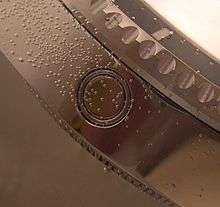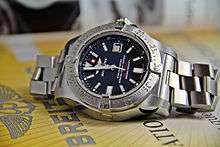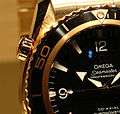Helium release valve
A helium release valve, or helium escape valve, as it is also called, is a feature found on some diving watches. It provides functionality for professional divers operating at great depths for prolonged periods of time or under saturation.
When commercial divers operate at great depths, they often spend prolonged hours in diving bells under pressure breathing a breathing gas mix like trimix or similar, that contain the gases helium or hydrogen. Since helium atoms are the smallest natural gas particles found in nature, these gas atoms are able to work their way inside the watch, around any o-rings or other seals the watch may feature. This is not a problem as long as the divers stay under pressure, but when the decompression stops during resurfacing aren't long enough, a pressure difference builds up between the trapped gas(es) inside the watch case and its environment. Depending on the construction of the watch case and crystal, this effect can cause damage to the watch, such as the crystal popping off.
While many watch companies react to this effect by simply offering an even more robust case/crystal construction, Rolex and Doxa S.A. however thought of a different concept when they co-created the helium escape valve in the 1960s (first introduced in the Rolex Submariner/Sea-Dweller and the Doxa Conquistador): A small, spring-loaded one-way valve integrated in the watch case that is activated when the differential between the inner and the outside pressure reaches a critical level. As a result; the valve releases the helium, hydrogen and/or other gases used in the breathing gas mix trapped inside the watch case.
Automatic helium release valves usually don't need any manual operation. There are however helium release valves featuring an additional screw-down crown at the side of the watch. When the diver starts to ascend, the diver simply unscrews the valve's crown to the full open position, allowing any breathing gas that may have been trapped inside the watch to escape during decompression.
Helium release valves can primarily be found on mechanical diving watches featuring a water/pressure resistance greater than 300 m (1000 ft) and therefore positioned as more extreme dive watches. Models that feature a helium release valve include most of the Omega Seamaster series, Rolex Sea Dweller, some dive watches from the Citizen Watch Co., Ltd, Breitling, Girard-Perregaux, Panerai, Mühle Rasmus by Nautische Instrumente Mühle Glashütte, all watches produced by Enzo Mechana, Aegir Watches and selected Doxa, selected Victorinox models, Oris models and TAG Heuer Aquaracer models, as well as the DEL MAR Professional Dive 1000 watch. Other watch manufacturers such as Seiko still offer high-level dive watches that are guaranteed safe against the effects of helium gas without needing an additional opening in the case in form of a release valve. The most extreme mechanical diving watch equipped with a helium relief valve is the 20,000 foot by CX Swiss Military Watch, the current world record holder for mechanical diving watches and featured in the Guinness Book of World Records.
Gallery
-

An integrated Helium release valve as used by Rolex for their latest version of the Rolex Sea-Dweller, the Deepsea.
-

An integrated Helium release valve as used by Breitling for the Avenger Seawolf.
-

A manually operated Helium release valve as used by Omega SA for their Seamaster dive watches, here the Planet Ocean.
-

A manually operated Helium release valve as used by Enzo Mechana for their entire line of dive watches. Pictured is the EM001 "Sub Hatch"